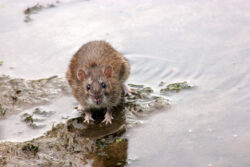Silver Springs Shores, with its warm climate and lush surroundings, is an attractive place to live. Unfortunately, the same qualities that make it appealing to residents also make it a haven for rodents. These pests can cause significant damage to property, pose health risks, and become a major nuisance. Understanding the common types of rodents in Silver Springs Shores is the first step to effective control and prevention. Discover the most prevalent rodents in the area and tips on how to manage and prevent infestations.
Common Rodents in Silver Springs Shores
Norway Rats
Norway rats, also known as brown rats or sewer rats, are large, with heavy bodies and a blunt nose. These rats are excellent burrowers and often make their nests in the ground, particularly around building foundations.
- Identification: Norway rats have brownish-gray fur, a scaly tail shorter than their body, and grow up to 16 inches long including the tail.
- Habitat: They thrive in urban areas, especially near water sources and food supplies.
- Risks: They can contaminate food, damage structures by gnawing, and spread diseases such as leptospirosis and salmonellosis.
Roof Rats
Roof rats, also known as black rats or ship rats, are one of the most commons rodent pests in Silver Springs Shores. They are slightly smaller and more agile than Norway rats. They are excellent climbers and are often found in elevated locations such as attics, roofs, and trees.
- Identification: Roof rats have sleek, black or dark brown fur, a pointed nose, and large ears. Their tails are longer than their bodies, and they can grow up to 14-15 inches in total length.
- Habitat: They prefer to nest in high places and are commonly found in attics, roofs, and trees.
- Risks: Roof rats can cause structural damage, contaminate stored food, and transmit diseases like typhus.
House Mice
House mice are smaller than rats and are among the most common rodent pests in homes. They are highly adaptable and can live in a variety of environments, often nesting in walls, attics, and cupboards.
- Identification: House mice have light brown to gray fur, a pointed nose, and large ears relative to their body size. They grow up to 7 inches in total length, including the tail.
- Habitat: They prefer indoor locations with easy access to food and shelter, often nesting within walls, attics, and storage areas.
- Risks: House mice can contaminate food, damage insulation and wiring, and spread diseases such as hantavirus and salmonellosis.
Preventing and Managing Rodent Infestations
Rodents can be challenging to control once they establish themselves in or around your home. Here are some effective prevention and management strategies:
- Seal Entry Points: Rodents can enter through small cracks and openings. Inspect your home for potential entry points and seal them with caulk, steel wool, or metal flashing.
- Eliminate Food Sources: Store food in airtight containers and clean up spills and crumbs promptly. Ensure garbage bins are tightly sealed.
- Maintain Cleanliness: Keep your home and yard clean and free of clutter. Regularly clean areas where food is prepared and consumed.
- Remove Nesting Sites: Clear away piles of debris, firewood, and dense vegetation that can provide shelter for rodents.
- Professional Pest Control: For persistent or severe infestations, contact a professional pest control company. They can provide thorough inspections, effective treatments, and ongoing monitoring to ensure your home remains rodent-free.
Experiencing rodents is never a good time! Give your local rodent control company a call for a free, no-obligation quote, and say goodbye to rodents!



